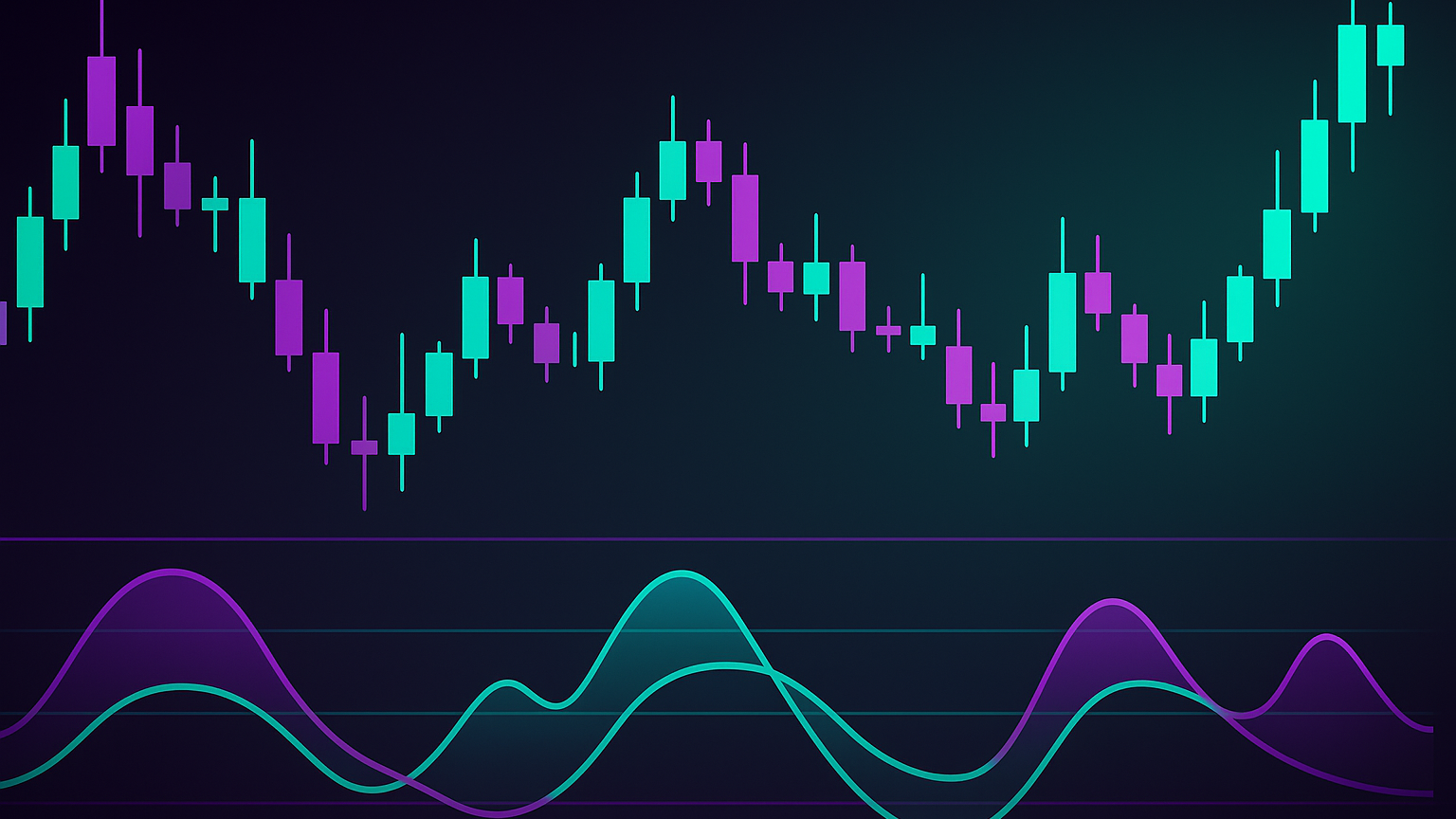Master Order Blocks to enhance your trading accuracy by identifying key price zones influenced by institutional trading activity.
Want to trade like the pros? Start by mastering Order Blocks (OBs). These are key price zones where institutions place large orders, leaving a lasting impact on market behavior. Understanding OBs can help you predict price movements more accurately than traditional support and resistance levels.
Key Takeaways:
- What are OBs? Zones on charts where institutional buying or selling has occurred, creating key support (bullish OBs) or resistance (bearish OBs).
- Why they matter: OBs highlight high-liquidity areas where price is likely to react, offering high-probability trade setups.
- How to identify them: Look for the last bearish candle before a strong upward move (bullish OB) or the last bullish candle before a sharp drop (bearish OB).
- Validation tips: Use volume spikes, liquidity sweeps, price imbalances, and multi-timeframe analysis to confirm OBs.
Pro Tip: Focus on higher timeframes (4-hour, daily) for stronger OBs and always apply risk management – risk only 1–2% of your account per trade.
Dive into this guide to learn step-by-step methods to spot, validate, and trade OBs effectively across markets like stocks, forex, and crypto.
How to Identify and Trade Order Blocks
Key Features of Order Blocks
Order blocks stand out due to specific traits and formation methods that separate genuine institutional trading zones from random price fluctuations.
Types of Order Blocks
Order blocks come in two main types, reflecting the institutional activity behind them. Bullish order blocks typically emerge after downtrends during accumulation phases. These often appear as bearish candles before a price moves upward, acting as potential support zones. On the flip side, bearish order blocks form after uptrends during distribution phases. These usually show up as bullish candles before a price declines, serving as potential resistance levels.
Recognizing these distinctions helps traders interpret the type of institutional activity at play and anticipate how prices might react when these zones are revisited. Understanding their formation sheds light on the market mechanics, offering insights into where large orders are concentrated. This categorization lays the groundwork for analyzing the specific price action patterns tied to order blocks.
Price Action Patterns
Order blocks are marked by distinct price action sequences, setting them apart from standard support and resistance levels. One of the most common patterns is the consolidation‑impulse sequence, where prices consolidate in a tight range before breaking out with strong momentum.
This sequence often begins with a liquidity sweep, where previous highs or lows are taken out. This action triggers stop losses and creates liquidity for institutional players. After this sweep, the order block forms as institutions execute their large orders, leading to a market move that creates Fair Value Gaps (FVGs) or imbalances – key indicators of institutional activity.
The presence of cleaner, more uniform candles often signals stronger institutional involvement, as large orders tend to produce smoother price movements rather than erratic fluctuations. Additionally, the order block should align with the broader market structure, fitting within prevailing trends or major turning points.
Once price action suggests an order block, further validation through volume and unmitigated conditions becomes critical. A simple rule of thumb: if the zone has already been fully revisited and traded through (mitigated), its edge decays quickly compared with fresh, unmitigated zones.
How to Validate Order Blocks
Validation confirms whether an order block originates from institutional activity or is simply a random price movement. Here’s what to look for:
- Volume spikes during the formation of an order block are a strong indicator. Institutional orders tend to generate significantly higher trading volumes compared to typical market activity.
- The order block must remain unmitigated, meaning it hasn’t been retested or "filled" since its formation. Once revisited, the liquidity within the order block is consumed, reducing its effectiveness as a trading zone.
- Look for price imbalances, where the market moves rapidly, leaving untraded price areas. This rapid movement reflects how large orders absorbed liquidity quickly, creating the imbalance that defines a valid order block.
| Validation Criteria | Importance |
|---|---|
| Volume Spikes | Confirms institutional order execution |
| Unmitigated Status | Ensures active orders remain influential |
| Price Imbalances | Indicates liquidity absorption and rapid movement |
| Liquidity Sweeps | Confirms institutional accumulation or distribution |
| Multi-Timeframe Visibility | Validates the zone’s significance across broader market perspectives |
Another key factor is multi-timeframe visibility. Order blocks that appear on higher timeframes often signal more substantial institutional activity, while those visible only on lower timeframes might lack the same weight.
Step‑By‑Step Guide to Finding Order Blocks
Identifying order blocks involves a structured approach that blends pattern recognition with technical analysis. The process starts with pinpointing consolidation periods that lead to strong price breakouts.
Finding Consolidation and Breakouts
The key to spotting order blocks is recognizing consolidation phases followed by decisive breakouts. Consolidation happens when a stock or security trades within a confined range, without continuing or reversing a larger trend. These periods are marked by well‑defined support and resistance levels, narrow trading ranges, and typically lower trading volume. The longer and tighter the consolidation range, the more significant the breakout is likely to be.
When the breakout occurs, a surge in trading volume often confirms its strength. However, false breakouts are always a risk, so it's crucial to wait until the price closes clearly outside the consolidation range before considering it a confirmed move.
For instance, during Q3 2022, TSLA traded between $680 and $720 for six weeks. It then broke above $720 with a 35% increase in volume, climbing to $800 within two weeks. This example highlights how analyzing consolidation periods can lead to successful identification of order blocks.
Once the breakout is confirmed, candlestick patterns provide further validation.
Using Candle Patterns for Confirmation
To confirm an order block, look for the last bearish candlestick before a strong upward move to identify bullish blocks, or the last bullish candlestick before a downward move to identify bearish blocks. Increased trading volume accompanying these patterns strengthens the signal.
To enhance accuracy, consider integrating Fair Value Gaps into your analysis.
Adding Fair Value Gaps
Fair Value Gaps (FVGs) offer another layer of confirmation for identifying order blocks. These gaps emerge when an imbalance between buying and selling creates temporary price inefficiencies. If a Fair Value Gap appears near a potential order block, it often signals active institutional orders, reinforcing the validity of the block.
To use FVGs effectively, start by identifying order blocks on higher timeframes like the 4‑hour or daily chart. Then, monitor for price retracements to these zones. During the retracement, check for Fair Value Gaps that formed during the initial breakout. When a consolidation breakout aligns with confirming candlestick patterns and a nearby Fair Value Gap, it creates a strong, multi‑layered system to reduce false signals and improve trading accuracy.
Tools and Indicators for Automated Order Block Detection
Automated tools have taken the concept of order block detection to the next level, building on traditional manual methods. Systems like Volume Profile analysis and the PAC Toolkit operate at lightning‑fast speeds, continuously analyzing market data to identify potential order blocks far more efficiently than any human could. LuxAlgo provides these tools on TradingView, combining manual techniques with advanced technical indicators to deliver precise insights.
LuxAlgo’s PAC Order Block Detection Algorithm
The LuxAlgo Price Action Concepts (PAC) Toolkit includes an automated order block detection system that highlights bullish and bearish zones in real time on TradingView. It continuously scans price action for qualifying structures and plots only the most relevant institutional zones on your chart. When a zone is mitigated—price revisits and trades through the level—the algorithm removes it automatically, keeping your layout clean and focused on active areas of interest.
- Multi‑Timeframe Detection – Project higher‑timeframe order blocks onto lower‑timeframe charts for added confluence.
- Dynamic Zone Filtering – Adjust sensitivity and display rules to control how many and what type of blocks are shown.
- Institutional Context Filters – Incorporates factors like liquidity sweeps, imbalances, and market structure breaks to prioritize stronger zones.
- Advanced Alerts – Set custom alerts for first touches, breaks, or mitigations so you’re notified the moment price interacts with a key zone.
For deeper validation and optimization, combine the PAC detection with LuxAlgo’s AI Backtesting Assistant. You can convert detections into rules, evaluate performance across assets and timeframes, and iterate on parameters to align with your risk profile—turning discretionary OB ideas into data‑driven strategies.

Volume Profile and Moving Averages
Volume Profile is a key player in automated order block detection. By highlighting areas of high liquidity and institutional activity, it identifies High Volume Nodes (HVN), which often coincide with crucial support and resistance levels. These HVNs frequently align with order block zones, making them essential for traders. Additionally, the Value Area – where ~70% of trading activity takes place during a specific time frame – pinpoints the most promising order block candidates.
Moving averages add another layer of confirmation when paired with Volume Profile. For example, EMA crossovers can signal the formation of bullish or bearish order blocks, while longer‑term moving averages often act as dynamic support and resistance levels. To maximize accuracy, it's essential to combine multiple indicators and rigorously backtest strategies based on Volume Profile insights.
AI Backtesting for Strategy Testing
Detection is only part of the equation – validating strategies is just as important. LuxAlgo’s AI Backtesting Assistant takes order block strategies and transforms them into data‑driven systems. By evaluating performance metrics and testing across various assets and timeframes, this platform helps optimize strategies in real time. Learn more in the Backtesting Assistant docs.
The Deep Optimization Engine explores multiple signal settings and parameter combinations to pinpoint configurations that fit a trader’s specific style. Instead of relying on gut feelings about order block strategies, AI Backtesting provides data to back up decisions, ensuring strategies are evaluated across different market environments.
To keep traders informed, the AI assistant can generate performance summaries that highlight effective order block setups in the current market. When combined with the PAC Toolkit’s detection capabilities, AI Backtesting creates a powerful system for developing, testing, and executing order block strategies with precision and efficiency.
Trading Strategies for Order Blocks
Once you've identified institutional order blocks, the next step is turning that knowledge into actionable trades. By selecting the right timeframes, setting clear entry and exit rules, and practicing disciplined risk management, you can effectively capitalize on these market patterns.
Timeframe Selection and Chart Setup
Start by analyzing higher timeframes, such as the 4‑hour, daily, or weekly charts. These provide a clearer view of institutional activity and reveal stronger order blocks. Use daily charts to pinpoint key order blocks, then zoom into lower timeframes like the 4‑hour or 1‑hour charts to refine your entries. This approach ensures you're aligning with the larger market trends while fine‑tuning your execution.
For even more precision, you can use 15‑minute or 5‑minute charts to identify entry points after spotting a strong order block on a higher timeframe. However, avoid using these shorter timeframes for the initial identification, as they often include excessive noise and misleading signals.
"The higher the TF, the stronger it is. Depends on the type of trader you are, and are you capable of waiting longer periods of time for your setup. Commonly, the 4HR and Daily would be best." – FallingMeteor_313
Keep your charts simple and uncluttered, focusing only on active order blocks. A clean setup helps you stick to your strategy and avoid distractions.
Entry and Exit Rules
When price approaches an order block, wait for confirmation before entering a trade. Look for a return candle near the block that signals a reversal with strong momentum. For bullish order blocks, enter long positions when price rejects a downtrend and shows signs of reversal. For bearish blocks, enter short positions when price rejects an uptrend. Ideally, the post‑entry price movement should display momentum that's 2–3 times the size of the original order block candle.
If you can't monitor the charts constantly, consider placing pending orders at the order block level. This ensures you won't miss opportunities when the price quickly touches the block and reverses.
Set your stop loss just outside the order block – below it for long trades and above it for short trades. For profit targets, you can use common tools such as Fibonacci extensions or measure the order block's size while factoring in the previous market structure. Always calculate your Risk‑Reward Ratio (RRR) before entering a trade to ensure the potential reward outweighs the risk.
Risk Management Best Practices
Effective risk management is essential, especially when trading order blocks, as market volatility can sometimes make them less reliable. A conservative approach, such as risking only 1–2% of your account per trade, helps safeguard your capital. For instance, on a $10,000 account, this means risking $100–$200 per trade.
"Sound risk management in order block trading involves the use of stop loss orders, appropriate position sizing, and limiting account exposure per trade to protect capital." – Saghar Hoseinpoor, Trading Guide Author
Always set a stop loss before entering a trade. Adjust its placement based on the asset's volatility and current market conditions. Focus on high‑probability setups with clear institutional footprints and strong confirmation signals for better consistency.
Before trading with real money, backtest your strategy on a demo account. This allows you to refine your entry and exit techniques and understand how order blocks behave in different market environments. Regularly reviewing and adjusting your strategy ensures it stays relevant as market conditions evolve.
To improve your success rate, combine order blocks with other tools like volume indicators or momentum oscillators. This layered approach helps you filter out weaker setups and focus on higher‑quality opportunities.
Common Problems and Solutions
False Breakouts and Liquidity Grabs
One of the biggest hurdles traders face is separating genuine order blocks from false signals that can lead to losses. It’s important not to label every consolidation as an order block – look for clear signs like liquidity sweeps and imbalances to validate them.
"A valid order block often features a takeout and liquidity sweep. This means the price moves beyond a previous high or low to grab liquidity, showing strong institutional interest." – XS.com
To spot genuine order blocks, confirm a liquidity sweep that breaks a recent high or low, followed by a sharp imbalance moving away from the zone. These are often accompanied by volume spikes, signaling institutional activity. When a legitimate order block is retested, you should see a strong rejection, indicated by reversal patterns or rejection wicks. On the other hand, fake order blocks tend to lack these characteristics and show weak price reactions upon retest.
To avoid false signals, ensure there’s evidence of a liquidity grab, observe a decisive price reaction on retest, check for clear imbalances, and confirm the block hasn’t already been mitigated. You can also strengthen your analysis by combining order blocks with tools like volume analysis or momentum indicators. Higher timeframes, such as H4 or Daily charts, generally provide more reliable zones compared to shorter timeframes, which can be noisy.
Don’t forget to evaluate the overall market environment to refine your order block analysis further.
Ignoring Market Context
Failing to consider the broader market context is another frequent mistake. Market trends, economic news, and key support or resistance levels all play a role in price behavior. Aligning your order blocks with the larger trend direction is essential. Trading against the prevailing trend increases your risk, even if the order block looks technically valid. Before entering a trade, analyze market trends, news events, and economic data to ensure your order block aligns with the broader sentiment.
Order blocks often form at key turning points or after sustained trends. Understanding this context helps distinguish legitimate institutional zones from random price movements. Staying aware of the economic calendar is also critical, as major news events can either create new order blocks or invalidate existing ones.
To enhance your analysis, look for confluence between your order blocks and other factors like significant support/resistance levels, trend lines, or common Fibonacci retracements. This layered approach filters out weaker setups and focuses on higher‑probability opportunities. Regularly reassess your identified blocks as market conditions change. For example, a bullish order block in an uptrend may lose its relevance if the market turns bearish. Flexibility is key to adapting your analysis as the market evolves.
Using Too Many Indicators
Clarity is crucial in trading, and overloading your charts with indicators can do more harm than good. Many traders clutter their charts with too many tools, which can lead to confusion and analysis paralysis. This often results in conflicting signals and missed opportunities.
Instead, keep your charts clean and focus on a few high‑value tools that complement order block analysis. Limit yourself to two or three key indicators, such as volume analysis and a momentum oscillator, to confirm order blocks. Prioritize quality over quantity – choose tools that genuinely add value to your decision‑making process.
It’s also important to adjust your approach based on market conditions. In trending markets, focus on order blocks that align with the trend direction. In ranging markets, target blocks forming near key support or resistance levels. Tailor your indicator selection to the current market environment instead of relying on a one‑size‑fits‑all setup.
Conclusion and Key Takeaways
Summary of Techniques
This guide walks you through both manual and automated methods for identifying order blocks. Manually, it’s all about spotting consolidations and pinpointing the final opposing candle before a sharp price move. For bullish order blocks, this means identifying the last bearish candle before a strong upward push. For bearish order blocks, look for the final bullish candle before a significant drop.
To confirm order blocks, check for liquidity sweeps, imbalances, and unmitigated conditions. Using multiple timeframes can improve accuracy and reliability.
If manual analysis feels overwhelming, tools like LuxAlgo’s Price Action Concepts (PAC) Toolkit simplify the process. This toolkit automatically identifies volumetric order blocks and offers in‑depth market structure analysis, saving you time and reducing the need for guesswork. Instead of manually marking charts, you can focus more on executing trades.
No matter how you identify order blocks, proper risk management is non‑negotiable. Always place stop losses slightly outside the block and limit your position size to 1–2% of your account balance per trade. Also, wait for confirmation signals – like rejection wicks or reversal patterns – when the price revisits the order block before entering a trade.
Final Tips for Success
To effectively use these techniques, disciplined execution is critical. Start by assessing the market context before searching for order blocks. For example, in an uptrend, focus on bullish blocks, and in a downtrend, target bearish blocks. Aligning with the broader institutional flow can help you avoid low‑probability setups.
Practice is key. Use demo accounts to test these strategies across different market conditions. Pay attention to how price behaves at these zones in trending versus ranging markets, and determine which timeframes best align with your trading style.
For stronger setups, combine order blocks with a few confirming tools like volume and a momentum oscillator. However, avoid overloading your charts – stick to two or three tools that genuinely enhance your decision‑making.
Backtesting is another essential step. Use historical data to evaluate how your strategy performs in various market scenarios. LuxAlgo’s AI Backtesting Assistant can help refine your approach by testing different parameters and timeframes, allowing you to optimize your strategy.
Order blocks are versatile and can be applied to markets like stocks, crypto, forex, and futures. Stay adaptable as market conditions change, and always prioritize risk management over chasing profits. By following these streamlined strategies, you’ll be better equipped to trade order blocks effectively across a variety of markets.
FAQs
How can I tell if an order block is valid or a false signal in trading?
To spot a valid order block and steer clear of false signals, you’ll want to focus on specific traits that confirm its authenticity. A true order block typically emerges after a consolidation phase, followed by a strong price movement. This indicates notable buying or selling activity at that level. Pay attention to bullish or bearish candles that clearly reflect prior price action and point to a definitive market direction.
Another key sign is liquidity sweeps, where the price briefly pushes through a level to trigger stop losses before reversing. To refine your analysis, it’s helpful to pair order blocks with other tools like support and resistance levels or relevant technical indicators. This combination adds context and can help ensure the signal fits within the larger market picture, reducing the chances of acting on misleading signals.
What are Fair Value Gaps (FVGs), and how do they help identify order blocks?
Fair Value Gaps (FVGs) occur when there’s a sharp price movement that creates a noticeable gap, reflecting an imbalance between buyers and sellers. These gaps typically show up in a three‑candlestick pattern: the middle candlestick forms a gap between the high of the first and the low of the third. This gap signals an area where the market might return to "fill" the void, aiming to restore balance.
Order Blocks (OBs) are zones tied to large institutional orders, often found in areas with high liquidity. Interestingly, FVGs and OBs often overlap. When they do, FVGs can emphasize the significance of an OB by pointing to areas where price may either reverse or stabilize. By studying the relationship between FVGs and OBs, traders can pinpoint potential entry and exit points more effectively, refining their trading approach.
Why should traders use higher timeframes to identify order blocks, and how does it improve trading accuracy?
Using higher timeframes to identify order blocks is a smart move because it gives you a clearer view of the market's bigger picture. It filters out the short‑term price swings, or "noise", that can often lead to confusion. This broader perspective helps traders zero in on key price levels where institutional activity might be happening, providing stronger clues for making trade decisions.
When you focus on higher timeframes, your trading strategy naturally aligns with the market's overall direction. This alignment increases your chances of catching more meaningful price moves. It also helps you time your entries and exits with greater precision, which can improve your results and lower the risk of getting thrown off by minor, short‑term fluctuations.
References
- Price Zones (PD Zones)
- Support & Resistance – Dynamic
- Liquidity Sweeps
- Price Imbalances
- Pure Price Action – Order/BREAKER Blocks
- DTFX Algo Zones
- Session Sweeps
- Inversion Fair Value Gaps (IFVG)
- Dynamic Order Blocks
- Market Structure Breakers
- Breakouts with Tests/Retests
- Candlestick Structure
- LuxAlgo Toolkits on TradingView
- AI Backtesting Assistant – Main Page
- AI Backtesting Assistant – Docs
- Tesla Investor Relations (TSLA example)
- XS.com








